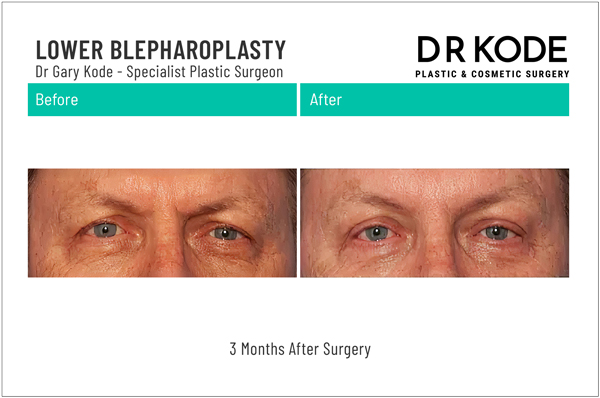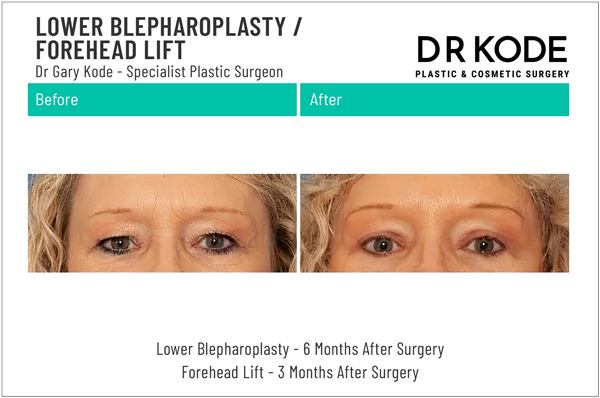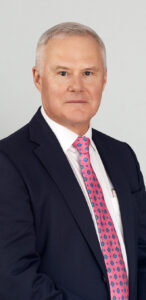- What Is Blepharoplasty?
- Why Do People Consider Blepharoplasty?
- Who Is a Suitable Candidate for Blepharoplasty?
- Types of Blepharoplasty Procedures
- Before and After Photos
- What’s Involved in the Procedure?
- Recovery After Blepharoplasty
- Potential Risks and Complications of Blepharoplasty
- How Much Does Blepharoplasty Cost in Melbourne?
- Medicare Eligibility for Blepharoplasty
- Choosing the Right Blepharoplasty Surgeon for You
- FAQs About Blepharoplasty
- Further Reading
- Considering Blepharoplasty in Melbourne?
As we age, the delicate skin around the eyes can begin to change, often resulting in eyelid ptosis (excess skin) on the upper eyelids, puffiness, or under-eye bags. These changes may be influenced by factors such as genetics, lifestyle, sun exposure, or the ageing process and can affect both appearance and in some cases, visual function.
Dr Gary Kode, Specialist Plastic Surgeon, offers individualised Blepharoplasty procedures, tailored to address concerns related to the upper and/or lower eyelids, while taking into account each patient’s facial structure and personal goals.
What Is Blepharoplasty?
Blepharoplasty, also known as Eyelid surgery, is a procedure that involves adjusting or removing excess skin, fat and muscle from the upper and/or lower eyelids. This surgery may be considered for functional reasons, such as when excess skin on the upper eyelid affects the field of vision or for individuals seeking a surgical approach to concerns related to the appearance of the eye area.
Why Do People Consider Blepharoplasty?
Individuals may consider Blepharoplasty for a variety of personal and functional reasons. While motivations vary, some recurring concerns include:
- Excess skin on the upper eyelids that may interfere with the field of vision.
- Prominent puffiness or fullness beneath the eyes.
- Changes to the shape of the eyelids due to skin redundancy.
- Challenges applying makeup due to skin folds on the upper eyelids.
Each person’s goals and experiences are unique. A consultation with Specialist Plastic Surgeon Dr Gary Kode will allow for a detailed assessment and discussion of whether this procedure may be appropriate based on your individual circumstances.
Who Is a Suitable Candidate for Blepharoplasty?
Blepharoplasty surgery may be an option for individuals who are concerned about changes to the upper or lower eyelids, such as excess skin causing obscured vision and are considering surgical options to address these concerns. While each patient is assessed on a case-by-case basis, suitable candidates often share some of the following characteristics.
- Have excess skin around the upper or lower eyelids that you would like addressed through surgery.
- Have developed vison impairment as a result of excess skin around the eyes.
- Are in generally good physical health, without conditions that could impair healing.
- Are a non-smoker or are willing to stop smoking for a recommended period before and after surgery.
- Have realistic expectations about the potential outcomes of the procedure.
- Do not have untreated eye conditions that may complicate recovery, such as severe dry eye or uncontrolled glaucoma.
- Understand both the risks and possible complications associated with eyelid surgery.
Dr Gary Kode will conduct a thorough consultation to determine your suitability for Blepharoplasty surgery and guide you through your available options.
Types of Blepharoplasty Procedures
Dr Kode offers both upper and lower blepharoplasty procedures:
- Upper Blepharoplasty: Involves the removal of excess skin and muscle from the upper eyelids to increase the patient’s field of vision or alter appearance.
- Lower Blepharoplasty: Targets under-eye bags or excess volume by removing or repositioning fat and muscle and tightening skin where appropriate.
These procedures can be performed individually or together, depending on your needs and goals.
Before and After Photos
Before and after images are for educational purposes only. The results shown are specific to each individual and may not reflect what another patient may experience. They are intended as a general guide to show what changes may be possible with Blepharoplasty performed by Dr Gary Kode. These patients have provided written consent for their images to be displayed.


Please visit our before and after gallery to view images. More images are available during a consultation with Dr Kode.
Disclaimer: Individual results vary depending on factors such as age, skin quality, medical history, and overall health. All surgical procedures involve risks. Photographs are not intended to guarantee outcomes.
What’s Involved in the Procedure?
Blepharoplasty is usually performed as a day procedure and may be completed under local anaesthetic with sedation or general anaesthetic, depending on your personal needs, the complexity of the surgery and whether it is being performed as a standalone surgery or alongside other procedures.
To help reduce visible scarring, incisions are strategically placed along the folds of the eyelids. The surgical steps differ slightly between Upper and Lower Blepharoplasty:
Upper Blepharoplasty Procedure
- An incision is made along the crease of the upper eyelid.
- Through this incision, excess skin is removed to help alter the eyelid appearance.
- In some cases, a small amount of muscle and fat may also be removed or repositioned.
- Once adjustments are complete, the incision is closed using fine sutures, designed to support healing and reduce scarring.
This approach can assist in addressing concerns such as heaviness in the upper eyelids or functional obstruction to the visual field caused by redundant skin.
Lower Blepharoplasty Procedure
- An incision is typically made just below the lower lash line or on the inside of the eyelid (a technique known as transconjunctival blepharoplasty), depending on the specific surgical plan.
- Through this access point, excess fat, muscle and skin may be repositioned or removed to reduce fullness or alter the appearance beneath the eyes.
- The incisions are then closed with fine sutures.
This technique is tailored to address concerns such as prominent under-eye bags or skin laxity.
Dr Gary Kode will discuss the most suitable approach for your unique anatomy during your consultation, as well as what you can expect before, during, and after the procedure.
Recovery After Blepharoplasty
Recovery experiences following Blepharoplasty can differ from person to person, depending on factors such as individual healing response, whether upper or lower eyelids (or both) were treated and whether the procedure was performed alongside other surgeries. However, most patients describe the recovery as manageable and gradual, with clear changes over time.
Common Postoperative Symptoms
During the initial healing phase, you may experience:
- Swelling and bruising around the eyes, which typically peaks within the first 48–72 hours and then begins to dissipate.
- A sensation of tightness or mild discomfort in the eyelid area, which can be relieved with prescribed or over-the-counter pain medication as advised by Dr Kode.
- Temporary blurred vision or light sensitivity, especially in the first few days due to swelling or eye ointment used during surgery.
- Watery eyes or dryness, which can be supported with lubricating eye drops if needed.
- Slight redness or sensitivity at the incision sites, which usually subsides as healing progresses.
Support During Recovery
Dr Kode will provide you with a personalised post-operative care plan tailored to your procedure and health needs. You will receive detailed instructions on how to care for your eyes, including guidance on:
- Cold compresses in the first 48 hours to help reduce swelling.
- Sleeping with your head elevated to reduce fluid accumulation and promote healing.
- Limiting screen time and avoiding activities that may strain the eyes.
- Protecting your eyes from direct sunlight or wind using sunglasses while outdoors.
It’s important to avoid the use of eye makeup, contact lenses, or rubbing the eyes until cleared by Dr Kode, to prevent irritation or disruption of the healing tissues.
Activity and Healing Timeline
Most patients are able to return to light, non-strenuous activities such as desk work within 7 to 10 days, though visible swelling or bruising may persist beyond this period. Activities such as exercise, heavy lifting, or exposure to dusty environments should be avoided for at least 2 to 3 weeks or until advised.
While some changes in appearance may be visible soon after surgery, final results may take several weeks to months to fully develop as residual swelling subsides and the tissues continue to settle.
Ongoing follow-up appointments with Dr Kode will help monitor your recovery and make sure everything is progressing as expected.
Potential Risks and Complications of Blepharoplasty
As with all surgery, Blepharoplasty carries potential risks and complications. These include:
- Bleeding or haematoma (collection of blood): May require medical attention if blood collects beneath the skin.
- Infection: Any surgical site can become infected, usually requiring antibiotics.
- Delayed wound healing: Some individuals may take longer to heal, especially if underlying health factors are present.
- Poor scarring: Scars may become more visible, thickened, or raised than expected. Some patients may develop keloid scarring.
- Dry eyes or irritation: Temporary dryness, itching, or discomfort in the eyes can occur.
- Temporary blurred or double vision: Vision changes may happen for a short period after surgery.
- Difficulty closing the eyes fully: This may occur during the healing period and, in rare cases, persist.
- Asymmetry between the eyelids: Eyelids may heal differently, leading to increased asymmetry. This may necessitate the need for revision surgery.
- Changes in skin sensation: Numbness or altered sensation around the eyelids can develop, which may be temporary or persistent.
- Anaesthesia-related complications: Risks associated with anaesthesia, though uncommon, can include allergic reactions or breathing difficulties.
All risks and possible complications will be discussed in detail during your consultation with Dr Kode. Visit our Risks and Complications page for more information.
How Much Does Blepharoplasty Cost in Melbourne?
The cost of Blepharoplasty can vary depending on several factors, including whether the procedure involves the upper eyelids, lower eyelids, or both. Additional considerations such as hospital and anaesthetic fees, the complexity of the surgery, and whether it is being performed alongside other procedures will also influence the overall cost.
After your consultation with Dr Kode, you will be provided with a personalised quote tailored to your surgical plan. In some cases, private health insurance or Medicare may offer rebates if the procedure meets specific medical criteria (outlined below).
Medicare Eligibility for Blepharoplasty
Medicare eligibility for Blepharoplasty is assessed on a case-by-case basis and generally applies only when the procedure is considered medically necessary. To qualify for a rebate, there must be a demonstrated functional impairment, such as excess upper eyelid skin significantly obstructing your field of vision that impacts daily activities. This distinction is important, as procedures performed for aesthetic purposes alone are not covered.
Supporting documentation, such as visual field testing results or clinical photographs, is typically required to support a Medicare claim. Even if you are eligible for a rebate, there will still be out-of-pocket expenses, so it is important to factor this into your planning.
Choosing the Right Blepharoplasty Surgeon for You
Dr Gary Kode is a Specialist Plastic Surgeon with over 35 years of experience in performing eyelid and facial procedures. Dr Kode takes a personalised approach to surgical planning to help patients understand their options and make informed decisions.
FAQs About Blepharoplasty
Further Reading
- Read Dr. Kode’s Face Surgery Page
Considering Blepharoplasty in Melbourne?
Book a Consultation
To learn more about Upper and Lower Blepharoplasty in Melbourne or to schedule a consultation with Dr Gary Kode, please contact our clinic.
Disclaimer: This content is for general educational purposes only and does not constitute medical advice. All surgery carries risks. A thorough consultation with a qualified health practitioner is essential to determine whether a procedure is appropriate for your individual needs.


